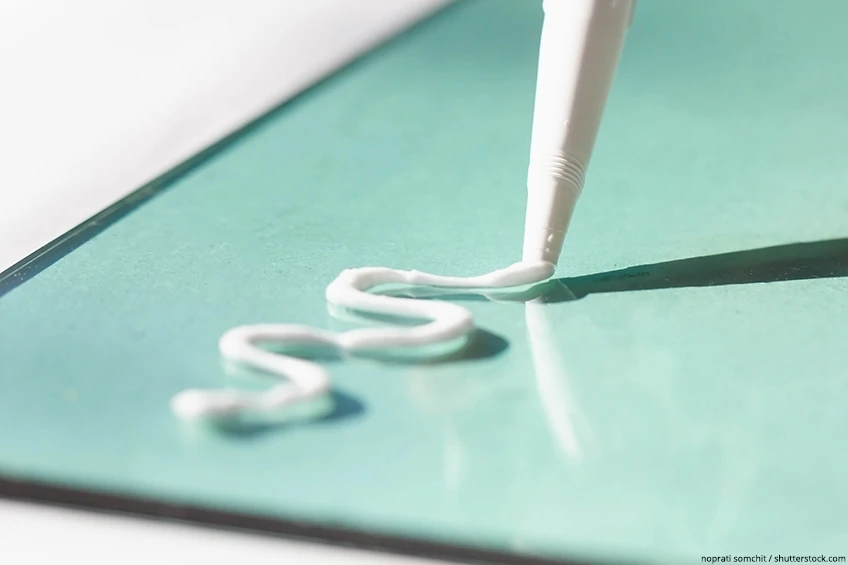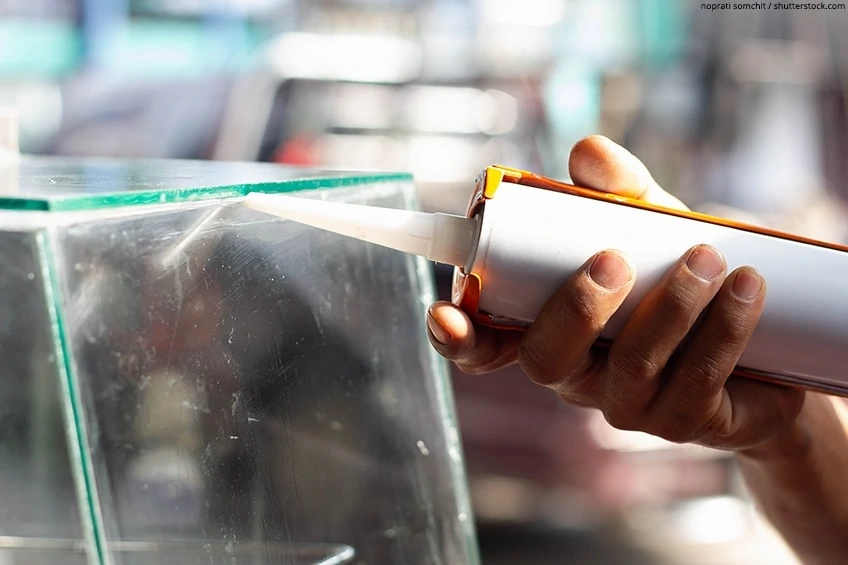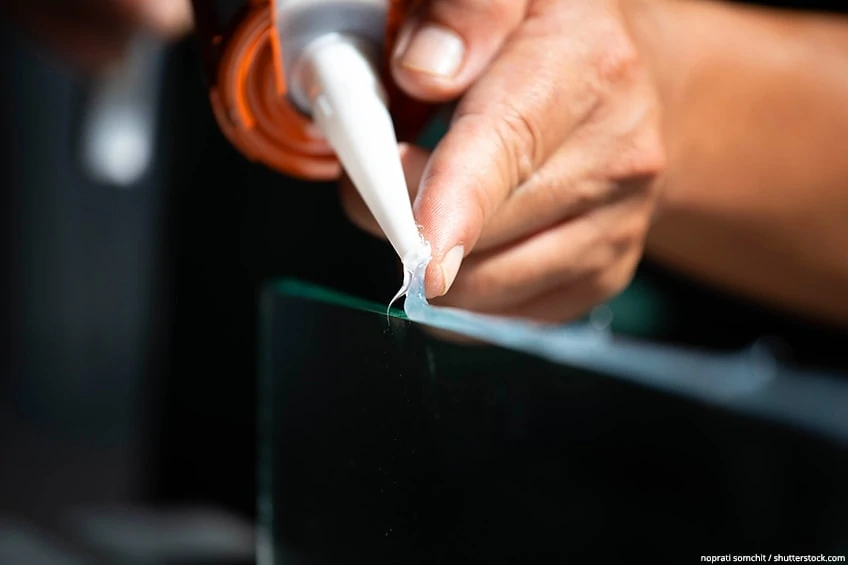Best Glue for Acrylic Plexiglass – The Top Plexiglass Adhesives
This post may contain affiliate links. We may earn a small commission from purchases made through them, at no additional cost to you. You help to support resin-expert.com
Everyone is familiar with polymethyl methacrylate, although not under this name. More familiar is the name Plexiglas, commonly spelled as Plexiglass, which was patented by Dr. Otto Röhm and refers to a material with very favorable properties. However, Plexiglass bonding is not exactly easy, because there are a few things to consider. We will tell you what these things are and how to glue Plexiglass or acrylic glass in our Plexiglass guide.
Table of Contents
What Is Plexiglass?
In 1928, the material PMMA, polymethyl methacrylate, was invented simultaneously in three different countries – Germany, Spain, and England. Dr. Otto Röhm then developed it further until it was ready for series production and patented the name Plexiglas. Nowadays, Evonik Industries holds the rights to the name. This is understood to be a plastic that is usually transparent, but can also be colored, and has ideal properties for many different applications:
- In optics, Plexiglass is used for lenses, magnifying glasses, and diffusing screens and prisms, among other things.
- The automotive industry benefits from the transparency and stability of Plexiglass and uses it, among other things, for glazing and caravan windows, as well as for bus skylights.
- In electrical engineering, Plexiglass is used for the construction of protective screens and luminaire covers.
- The construction industry uses this material for lighting fixtures, protective glazing, shower enclosures, and skylight domes.
- Especially in the hobby area, Plexiglass is vastly popular in model making.
- Aquariums and vending machines are also often provided with Plexiglass.
By the way, Plexiglass and acrylic glass cannot be used completely synonymously, because there are slight differences in their chemical composition.
The Best Glue for Plexiglass
Before you even start gluing Plexiglass, you should find out whether the material at hand is actually Plexiglass or something else. Sometimes, materials similar to Plexiglass are mistakenly called Plexiglass or even acrylic glass, when in fact it is PVC. This makes a considerable difference in the bonding process and can, in the worst case, lead to poor bonding, which will result in breakage of the adhesive seam or even damage to the material.
After that, you need to ask yourself whether you want to bond Plexiglass to Plexiglass or to another material. For example, if you want to glue Plexiglass to wood, you should consider the different material properties: While Plexiglass is smooth, wood is a porous material.
Furthermore, the adhesive used should adapt perfectly to the transparent Plexiglass and not lead to any clouding of the bonded material. The following Plexiglass adhesives are perfectly suitable for Plexiglass or acrylic glass bonding with various other materials:
| Gluing Plexiglass to… | Suitable Adhesive |
| Plexiglas | Acrylic Adhesive, Silicone Rubber, Superglue, Epoxy Adhesive |
| Metal | Silicone Rubber, Superglue, Epoxy Adhesive |
| Stone | Silicone Rubber, Superglue, Epoxy Adhesive |
| Ceramics | Silicone Rubber, Superglue, Epoxy Adhesive |
| Heart plastics | Acrylic Adhesive, Silicone Rubber, Superglue, Epoxy Adhesive |
| Rubber | Superglue |
It should be noted that the superglue listed in the table may only be used if the glued seam is not exposed to high temperature fluctuations.
With this knowledge, we can move forward to find the best glue for plexiglass:
Gluing Plexiglass with Superglue
Everyone has superglue in the house. It not only has the advantage of curing very quickly, but it also bonds many different materials permanently and very durably. If superglue is to be used as a Plexiglass adhesive, you should note that it does not have gap-bridging properties. The parts to be bonded must therefore be an exact fit.
We have carried out a superglue test and present the test winner to you: Loctite Professional Liquid Super Glue. This is Plexiglass glue of a professional strength that will work quickly to provide a strong and lasting bond. The formula also resists moisture, cold temperatures, and most chemicals. The pinpoint nozzle allows for precision and detail, and should close without clogging up. This is the ideal clear superglue for gluing Plexiglass.
- Professional-strength ingredients work fast and hold strong
- Fast-setting formula resists moisture, most chemicals, and the cold
- Pinpoint nozzle allows precise application without dripping or oozing
PROS
- Moisture-, cold, and chemical-resistant
- Quick-drying
- Dries clear
- Forms a strong and durable bond
CONS
- Small quantity in bottle
Since the Loctite Professional Liquid Superglue has only one disadvantage, but several advantages, it is the clear winner for us in our superglue test.
Areas of Application
Superglue is generally suitable for small and selective bondings that do not require a long pot life. The glued seam can be subjected to high loads once the adhesive has cured. This is because instant glue is a highly durable adhesive that can also withstand high loads. Superglue is only suitable for gluing Plexiglass if the glued area is not to be visible later. This is because superglue hardens white, so that it would look very unattractive on a transparent Plexiglass pane.
Application
Before using the instant adhesive, the gluing area must be cleaned. You can use isopropanol and a soft, lint-free cloth for this purpose. Then, the adhesive can be applied to one side and you can joint the substrates. If necessary, they can be fixed together, although this is not usually necessary with an instant adhesive.
Gluing Plexiglass with Acrylic Adhesive
Acrylic-based adhesives should be styrene-free and purchased as MMA adhesives. When these are applied to the Plexiglass, the adhesive and substrates form a chemical bond with each other, as the MMA and PMMA are chemically very similar. This results in extremely durable and resilient bonds.
Nevertheless, caution is also required with this type of acrylic bonding, as stress cracks can occur in the material after bonding. You should work as stress-free as possible. Acrylic glue generally has another major advantage: It virtually runs on its own. In this way, it optimally fills gaps between the substrates and therefore ensures a perfect bonding result.
We have tested various acrylic adhesives and came to the following conclusion: The Weld-On #4 Acrylic Adhesive. This adhesive is specially formulated to resist blushing, which is when white marks occur on the surface. This product offers a water-thin consistency that will dry quickly and clearly into a high-strength bond.
- Formulated as a blush-resistant cement for bonding acrylic to itself
- Creates clear and high-strength bonds
- Dries quickly with a long shelf life
PROS
- Blush-resistant
- Forms a strong and lasting bond
- Long shelf life
- Quick to set
CONS
- Tricky to use due to watery consistency
We give the Acrifix a crystal-clear buy recommendation not only because of its durability, but also because of its transparency.
Areas of Application
Due to its optimally timed pot life, transparent curing, and the resilience of the adhesive seam, an acrylic-based adhesive for Plexiglass is perfect for bonding over large areas. For example, you can glue a second Plexiglass pane onto a damaged one and repair it in this way. After the correct procedure, the acrylic adhesive will glue the two Plexiglass panes extremely tightly together.
Application
This adhesive also requires thorough cleaning before you glue the Plexiglass. After that, the adhesive can be applied on one side. Now, join the two substrates. It is important, especially when bonding Plexiglass on one side, to fix the substrates. This is not absolutely necessary with a superglue; however, an adhesive that has a longer pot life must first be able to develop its adhesive effect. During this time, the Plexiglass sheets may slip if not fixed.
Gluing Plexiglass with Acrylic Silicone
Acrylic silicone is also used as a Plexiglas adhesive. It is applied in thick beads in a serpentine pattern and minimizes the risk of air inclusions, especially when bonding acrylic glass over a wide area. The adhesive bonds that are created are high-strength and not at all pressure-sensitive. In addition, acrylic silicone is a very UV-resistant and weather-resistant adhesive.
In our acrylic silicone test, the J-B Weld All-Purpose RTV Silicone Sealant and Adhesive performed the best by far. This is a clear silicone sealant and adhesive, meaning that it offers two uses in one product. Easy to use, this product can be used by anyone wanting to achieve a lasting and durable bond between their Plexiglass surfaces. In fact, this adhesive is waterproof, weather-resistant, and will not crack or shrink, making it ideal for almost all surfaces. This adhesive remains flexible once cured, so it is most suitable for high-stress areas and joints.
PROS
- Two-in-one adhesive and sealant
- Forms a tough and lasting bond
- Waterproof and weather-resistant
- Resistant to cracks and shrinkage
- Works on a variety of surfaces
CONS
- Bottom part of tube prone to bursting
- Cannot be stored, so must be used in one go
For the above reasons, Ramsauer silicone sealant is the best acrylic silicone adhesive for us.
Areas of Application
Acrylic silicone is ideal for laminar Plexiglass bonding in particular. It effectively prevents air pockets from developing between the substrates, as the tough adhesive (provided it is applied thickly) blends in perfectly. In this way, it fills any gaps. It therefore also serves as a sealant during the bonding process and has a gap-filling effect.
Application
Acrylic silicone is applied in thick beads, so should be used generously to avoid the air pockets mentioned above. Beforehand, both substrates should be cleaned of dust, dirt, oil, and grease. When applying the adhesive, make sure that the air between the two substrates can escape towards the outer edges when joining.
Once you have applied the adhesive, you can join the substrates and then fix them. Follow the manufacturer’s data sheet and allow the acrylic silicone a little more time for the curing process rather than too little.
Gluing Plexiglass with Epoxy Glue
Epoxy resin adhesives work on the basis of two components, a resin and a hardener, which trigger a chemical reaction after mixing. The resin hardens and an extremely durable and resilient adhesive seam is formed, which can also be machined. Coloring epoxy resin adhesives is usually not a problem either. Furthermore, the adhesive can be provided with various additives and filling materials. However, care should be taken to ensure compatibility with the adhesive and the materials to be bonded so that the adhesive properties are not impaired.
Epoxy adhesives are suitable not only if you want to repair Plexiglass, but also if you want to glue Plexiglass to other materials. For example, if you want to bond Plexiglass to wood, the two-component epoxy adhesive is the method of choice. Here, too, it is important to take into account not only the different coefficients of thermal expansion, but also the stress on the bonded areas. If the bonded joint is to be elastic and flexible, it is better to use a silicone-based adhesive rather than an epoxy resin adhesive.
As for this one, we also did an epoxy adhesive test and found the following: The Araldite Rapid Strong Epoxy Adhesive offers the user not only the best price-performance ratio, but also everything one will need for safe and durable bonding of different materials. This is a professional-grade product that offers a strong and lasting bond that is resistant to water, chemicals, impact, oil, and certain temperatures.
It sets quickly and clearly and can be used on many different materials. This two-part epoxy may be difficult to mix initially, as the separate tubes make it harder to achieve the perfect mixing ratio. Other than this, you will be hard-pressed to find a more effective product.
- Strong and long-lasting two-part epoxy adhesive
- Sets and dries quickly
- Multi-use application
PROS
- Transparent once cured
- Cures quickly
- Resistant to water, oil, temperature, impact, and chemicals
- Forms a durable and lasting bond
CONS
- Difficult to achieve correct mixing ratio due to separate tubes
Apart from this single disadvantage, we are more than happy to give the Araldite epoxy adhesive a glowing recommendation!
Areas of Application
A two-component adhesive based on epoxy resin is a particularly suitable glue for acrylic glass if you want to bond the acrylic to a non-shrinking material. Although an epoxy adhesive is sometimes described by manufacturers as vibration-damping and durable despite high-impact loads, acrylic adhesives or acrylic silicone are more suitable for use on shrinking and vibrating workpieces.
Application
Before the actual application, the two components of the adhesive must be mixed together. If this has been supplied in a double-chamber cartridge, this step is as easy as can be: Simply press the cartridge and empty the desired amount of adhesive onto a suitable base. The two components emerge in the optimum mixing ratio. Alternatively, measure out equal amounts of each substance and mix them together in a suitable mixing dish.
Now, mix both components with the aid of a wooden spatula until a homogeneous mass has been created. You can also use a mixing nozzle, but mixing by hand is usually sufficient. It should be noted that a mixing nozzle for mixing epoxy adhesives can only be used once. After that, it is unusable.
The surface of the substrates must be free of grease, oil, and dirt as well as dust deposits. After a thorough cleaning with acetone or isopropanol, the surface is lightly roughened and then cleaned again. The adhesive can then be applied thinly on one side. It is advisable to carry out the preparatory work before mixing the adhesive, as you only have a short pot life.
The substrates are now joined. After about a quarter of an hour, very good manual strength is already achieved. The final strength is reached after about 24 hours. Until then, the substrates should be fixed together.
Tips and Tricks on How to Glue Plexiglas
- If you need a really durable and stable adhesive bond, you can anneal the substrates at 158° Fahrenheit (70° Celsius)s before and after the bonding process. This procedure is particularly recommended for acrylic-based adhesives.
- Some adhesives react in an undesirable way with other materials, especially if they are sensitive materials. To avoid possible dissolving of these materials, it is essential to mask them carefully before working with aggressive adhesives. Leaked adhesive residues that have not yet dried should be picked up immediately after joining with a lint-free cloth or kitchen paper to avoid unsightly noses.
- Especially with Plexiglass, cleaning in advance is immensely important, because with this transparent material, any dirt and dust inclusions are visible after the bonding process.
- When bonding some materials, an adhesion promoter can be advantageous.
Frequently Asked Questions
Can You Glue Plexiglas to Wood?
This is usually possible without any problems if you lightly roughen the wood and then thoroughly clean the area to be glued. For large surfaces, a spray adhesive is suitable, which is sprayed on very thinly.
Can You Glue Plexiglass with Silicone?
Gluing Plexiglass with silicone is not a problem, because it acts as a good and durable adhesive. Ensure optimum surface preparation and use a primer if necessary.
Can You Glue Plexiglass with Hot Glue?
Especially in the do-it-yourself sector, Plexiglass bonding is easily possible with the aid of a hot glue gun. However, the glued seam must not be subjected to any major stresses afterwards, so the above-mentioned adhesives, such as an acrylate adhesive or a two-component epoxy resin adhesive, are more suitable for durable and stable bonding.
Gluing Plexiglass is possible without any problems. The most important thing is the right adhesive and optimal surface preparation. It is best to follow our plexiglass adhesive test and guide, as then nothing can really go wrong.








